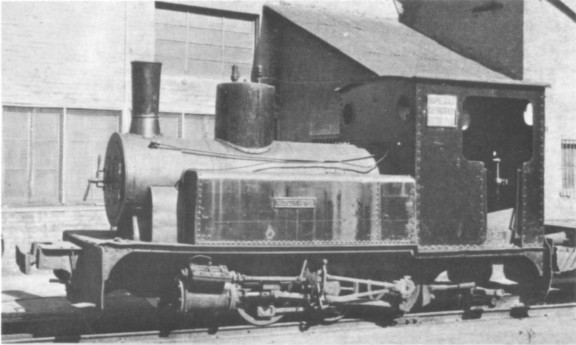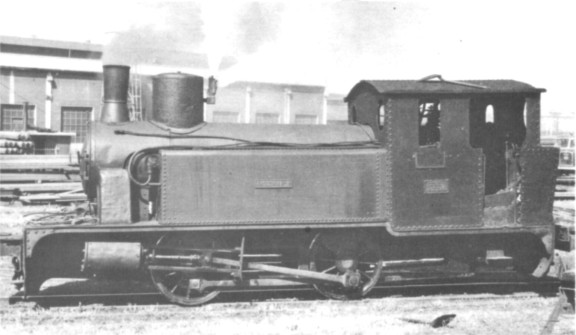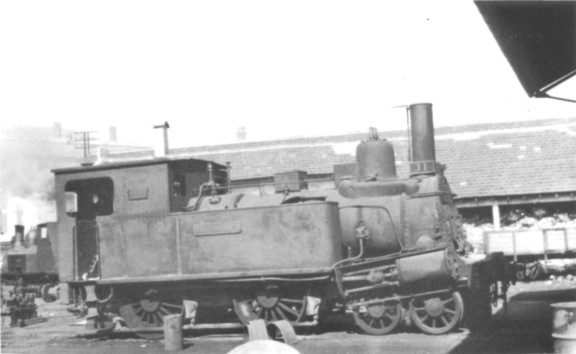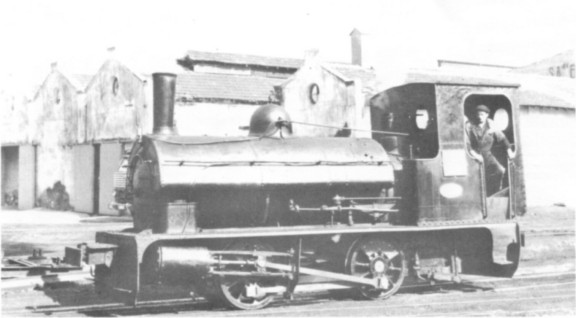
| THE INDUSTRIAL RAILWAY RECORD |
© JUNE 1968 |
BASCONIA STEELWORKS
FRANK JONES
(Photographs by the Author)
The Basconia steelworks of Sociedad Anonima "Basconia" in Bilbao, Spain, lie between the RENFE line to Miranda and the new trunk road going to the same place. Indeed a good view of the shed is to be had from the RENFE. It is possible to see a fair amount without a permit, but a gateman is on duty at each works entrance. However, armed with a permit I made a visit here at Easter 1966. The weather had just turned out gloriously fine after a most miserable, cold and wet holiday.
After the usual formalities I was taken to the shed to see the metre gauge shed pilot - Sharp Stewart (Manchester) 3031 of 1881. In superb condition, she had previously worked at the Somorrostro Mines to the northwest of Bilbao and had arrived at Basconia in 1951. Known as "17" but carrying no number she is a typically British 0−4−0 saddle tank. To describe the five 0−6−0 side tanks is not easy as they all have detail differences. No.9 and No.10 are similar with outside valve gear driven off the rear axle, rear bunkers and medium wheelbase; they were built by Cockerill in 1885 (No.10 is Cockerill 1453) for the Bilbao-Las Arenas-Plencia suburban line, and came to Basconia in the early 1920's. Nos.5, 7 and 14 have cabs similar to one another but with front bunkers and short wheelbase. While No.7 drives her valve gear off the middle axle, Nos.5 and 14 drive off the rear axle by eccentrics. No.14 which carries a plate indicating that she was built by Basconia in 1933 has a higher pitched boiler compared with the other two. No.5 has single slide bars, while all the others have double. The last narrow gauge locomotive is No.3, an 0−4−0 side tank with a long wheelbase and a big overhang at the rear; she was built by Basconia in 1936.
We come now to the three 5ft 6in gauge locomotives. Nos.12 and 13 are cumbersome 0−6−0 side tanks with an interesting history; they started life as 0−6−0 tender locomotives on the Madrid-Caceres-Portugal Railway and came to Basconia in 1929 as scrap metal, but were rebuilt as side tanks and put into service in the steelworks. The detail differences are that No.12 has a straight topped boiler with one dome while No.13 has a boiler with two domes and a raised firebox; also the counterbalancing of the wheels differs. No.13 has some driving wheels stamped "116" which would seem to have been the MCP number. However the third locomotive on the broad gauge is the showpiece. She is No.11, a 4−4−0 side tank by Beyer Peacock (No.295 of 1863), having been built to a design which preceded the famous Metropolitan 4−4−0 tank, formerly No.29 IZARRA of the Bilbao-Tudela Railway (later Norte) she was acquired by Basconia in 1927. Eight locomotives of this type (Beyer Peacock Nos.293-300) were built for the Bilbao-Tudela Railway and No.11 at Basconia is the only example to survive intact. The first of the class, No.27 AMURRIO, went to the sugar factory at La Poveda, near Madrid, but was dismantled about 1962 and as far as is known is still in this condition. It is pleasing to know that although No.11 has been withdrawn the present owners have agreed to withhold the scrapping of this very interesting locomotive since plans are being made to include her in the proposed RENFE museum.

BASCONIA No.5 on the metre gauge.

BASCONIA No.3 (built Basconia in 1936) on the metre gauge.

BASCONIA No.11 (Beyer Peacock 295 of 1863) on the 5ft 6in gauge.

Sharp Stewart 3031 of 1881 on the metre gauge.
I have a note that some Kitson locomotives, works numbers not known, were supplied to Basconia. An interesting point is that the metre gauge locomotives have radiused edges to the tank tops, and this was a Kitson feature. Apart from Nos.9, 10 and "17" the origins of the metre gauge locomotives are most obscure and I would like to hear of any additional information. In the meantime I would thoroughly recommend a visit to the works while the stock is still with us.
Acknowledgements are due to Ron Fraser for some of the historical information included above.
(On a hurried visit in September 1965 we noted on the metre gauge three 4−wheel petrol, six 4−wheel diesel and three steam locomotives additional to those recorded by Mr.Jones. The three steam, all dumped and presumably since scrapped, were an unidentified 0−4−0 side tank (No.6) and two 0−6−0 side tanks - 1 BILBAO (Krauss 2454 of 1891) and 3 LEZAMA (Krauss 2504 of 1891). The last two, known as 15 and 16, were said to have arrived at Basconia about 1955 from the Bilbao-Lezama Railway. Of this huge stock of locomotives, only five were working - two steam and two diesels on the metre gauge and No.13 on the 5ft 6in gauge. - Hon. Eds.)